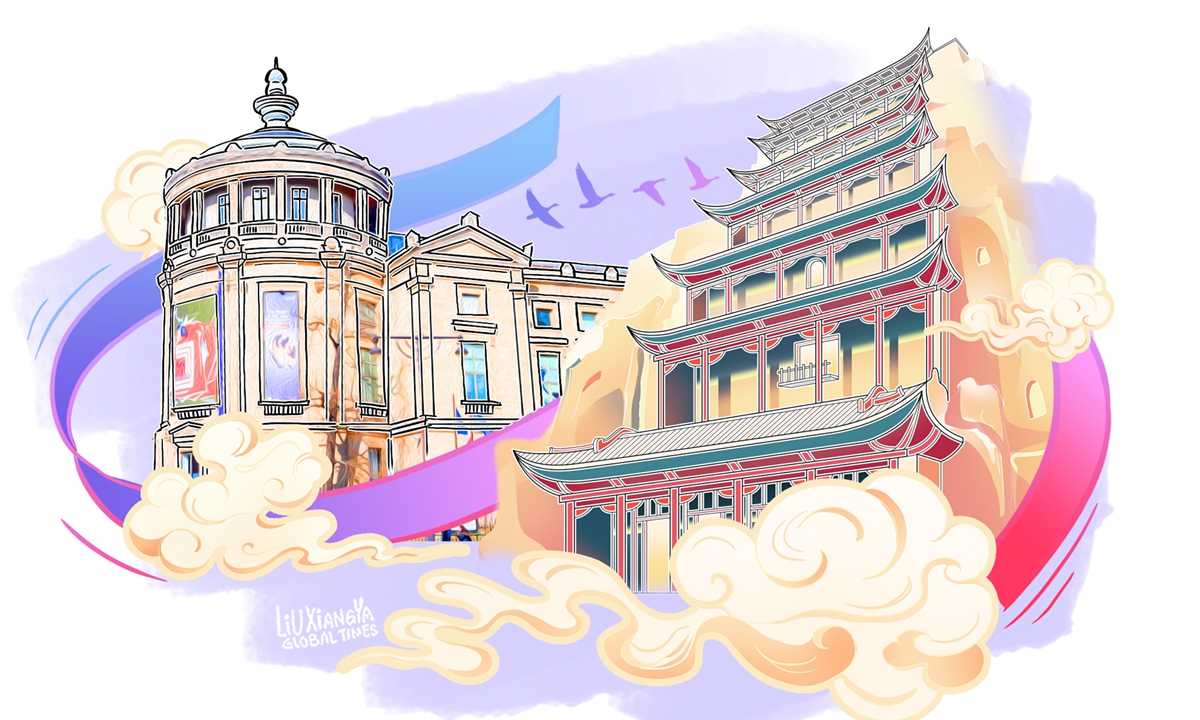
Illustration:Liu Xiangya/GT
The Guimet National Museum of Asian Arts in Paris, France, aims to assist young French individuals in understanding the history of China and Asia. Only by knowing China's past can we grasp its present, thus facilitating better communication and dialogue between cultures.
Chinese President Xi Jinping said that "civilizations have become richer and more colorful with exchanges and mutual learning. Such exchanges and mutual learning form an important drive for human progress and global peace and development." He said this in a keynote speech at the headquarters of the UNESCO in Paris in 2014, articulating China's advocacy for exchanges and mutual learning between civilizations. I wholeheartedly endorse the promotion of such exchanges.
Our museum stands as one of Europe's largest museums dedicated to Asian art. It is my responsibility as its president to broaden the perspectives of the French and European people toward Asia. Our younger generation should understand other civilizations, with a particular emphasis on Asian civilizations, especially Chinese civilization. We hope to aid young French individuals in comprehending the history of China and Asia, as only through understanding China's past can we foster better communication and dialogue.
Over the years, there has been mutual exchanges between the civilizations of France and China.
In 2019, at the suggestion of Sophie Makariou, the former president of the museum, French President Emmanuel Macron presented President Xi with a precious copy of an original French version of
An Introduction to The Analects of Confucius published in 1688. This national gift underscored the significant influence of Confucian thought in France and served as evidence of the longstanding exchanges between the two nations.
On April 1, I attended the opening ceremony of the exhibition
The Forbidden City and the
Palace of Versailles: Exchanges Between China and France in the 17th and 18th Centuries at the Palace Museum in Beijing. This exhibition showcased the mutual cultural influence between France and China. From what I know, French artists like Pierre Soulages in the 20th century were particularly enamored with Chinese art, especially calligraphy, and Chinese painters have integrated elements of both French and Chinese artistic styles. Both France and China are drawn to each other's cultures, yielding many beautiful stories of interaction.
This year marks the 60th anniversary of diplomatic relations between France and China, as well as the China-France Year of Culture and Tourism. In this significant year, the Guimet Museum will play a crucial role in promoting cultural exchanges between the two nations by hosting a year-long series of exhibitions and activities showcasing Chinese art and culture.
In June, we will launch a large-scale exhibition on Chinese monochrome porcelain, followed by a special exhibition on Ming Dynasty (1368-1644) goldware in collaboration with Chinese cultural institutions starting in September and then a grand exhibition on Tang Dynasty (618-907) themes in November, featuring artifacts sourced from China. We are committed to providing comprehensive Chinese cultural experiences by adding Chinese introductions to our museum galleries and website, with the Chinese version of the museum website set to launch later this year.
During March and April, I embarked on a three-week visit to China, where I attended the inaugural Hong Kong International Cultural Summit, participated in the Boao Forum for Asia Annual Conference 2024, and signed cooperation agreements with institutions such as the Dunhuang Academy, the National Museum of China and the Palace Museum.
Dunhuang was a particularly significant stop during my visit to China. The Guimet Museum has collaborated with the Dunhuang Academy for years. During this visit, we signed a memorandum of cooperation focusing on the construction of a comprehensive "digital cave library," deepening cooperation in academic research, exchange, and talent development, and launching more specific and long-term cooperation projects. We have also established a joint cooperation committee composed of personnel from both sides. I am honored to have been appointed as a "global ambassador for Dunhuang culture" and will make efforts to promote Dunhuang's cultural and artistic heritage. For me, this is an important responsibility.
I spent a lot of time in Chinese museums during my visit, and they made a profound impression on me.
With over 6,000 museums in China, I have only visited 20, yet I have fully experienced the dedication of my Chinese colleagues to exhibition curation. Chinese museums are filled with young people, which is particularly admirable.
I hope that the Guimet Museum will strive in this direction as well, attracting more young audiences and helping them better understand Asia, particularly China.
The author is the president of the Guimet National Museum of Asian Arts in Paris, France. [email protected]
URL: https://www.seeglobalnews.com/read-3578.html